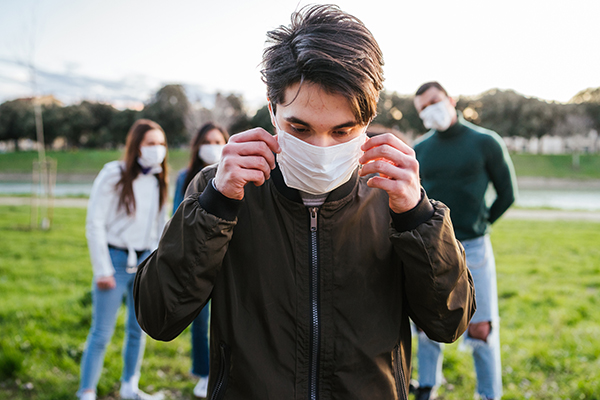At the start of COVID-19 social distancing, the large parking lot a short walk from the house had been virtually empty, a place for children to ride bikes without getting too close to other kids or for homebound families to experience a change of scenery.
As those requirements increased, so did the number of cars filled with teens populating the lot. They hung out the necessary number of feet apart, perched on top of and next to their vehicles, technically following the rules, yet stretching them to near-breaking point.
Though that scenario has happened, it’s still an anecdote. It’s too early in the situation caused by the novel coronavirus for research to explain how adolescents as a population are behaving. But it does reinforce an important notion about this group, says Penn psychologist Sara Jaffee: They have a deep-seated need for their friends.
“Adolescents typically spend a lot more time with their peers than with their parents,” says Jaffee, whose research looks at how trauma affects children. “They’re trying out new identities, getting feedback from friends, gathering information about what constitutes acceptable behavior within the peer group and what doesn’t. Friends and peers become really valued sources of information about the world.”
So, as the majority of the people in the United States have been asked to stay home, adolescents are finding their own way. And their coping mechanisms and needs will likely look different from those of younger siblings or college-age children now back in the house, a crucial facet for parents to understand in trying to provide guidance and lay new ground rules for this unprecedented situation.
“Inherently, adolescents want to be together,” says Catherine McDonald, a School of Nursing researcher who studies teenagers and distracted driving. “They’re at a developmental stage when peer relationships are really important. That’s why some of this is really hard for them. They can’t be physically with their peers and friends.”
The importance of this connectedness has played out in McDonald’s research, which found that although teenagers understand the dangers of using cell phones while driving, they do it because of their desire to know what’s happening with their peers and to stay in touch with what’s being discussed on social media. Focus groups McDonald conducted with teenagers also showed the great influence their friends have over their actions.
This stems partially from the fact that certain areas of the brain—the amygdala and striatum for example, which are responsive to approval and social feedback—are fully mature by puberty. The prefrontal cortex, which is responsible for planning and inhibition, is not. “As a result, adolescent behavior can look really impulsive and reckless, particularly in situations where the behavior is being motivated by seeking friend or peer-group approval,” Jaffee says. “Teenagers lack the cognitive machinery to think about the long-term consequences of what they’re doing.”
That’s particularly problematic in relation to COVID-19, an invisible foe that’s less likely to affect them than other age groups. Plus, “their friends are a really strong temptation, a tantalizing reward,” Jaffee says. “Adolescents are very sensitive to those rewards and very insensitive to the messages about inhibiting behavior that are being relayed to them by public health officials and by their parents.”
Despite that fact, parents aren’t out of options.
For one, they can and should engage in explicit conversations with their teens about just how strange this situation is—for everyone, McDonald says. Those discussions should also include what peer pressure looks like in the context of social distancing, particularly as the weather warms and some of the quarantine recommendations evolve. For example, if a mask-wearing, six-feet-apart bike ride is fine, how will the teen react when the riding ends and there’s an invitation into the friend’s house?
“Teens still have to navigate risky situations they may be in. That’s not going to change whether it’s driving behavior or alcohol or drug use or something as simple as not social distancing,” McDonald says. “It’s not just about parents making rules for the teens in their household. The same household rules may not apply right now because we’re not in a typical time period. There’s a much bigger, larger public health consequence to all that we do.”
That’s a tricky concept for anyone to grasp, so McDonald and Jaffee suggest personalizing what could happen by not following social distancing guidelines. Make it about someone the teen knows, a grandparent or an older neighbor, they say, rather than about the general public in the abstract.
And, though adolescents are likely spending much more time in the digital realm than they had before as in-person classes shifted to video platforms and homework now incorporates more online tools, they’ll still need time with their friends, perhaps more so than ever, Jaffee says.
She recommends facilitating as much access as possible to the peer group that doesn’t involve in-person get-togethers. “Maybe that means unrestricted screen time so that kids can be on FaceTime, texting, or messaging with friends,” she says. “Parents should consider letting up on screen-time restrictions during this particular period.”
Finally, accept that the approach will change—perhaps often—and that different-aged children in the household will need different guidance and allowances.
“What works for the 12-year-old isn’t going to work for the 17-year-old,” McDonald says. “When this all started it felt like we were putting a Band-Aid on the scrape, putting a little covering on it to figure it out for a moment. Families may now realize they need a bigger plan for the longer haul.”
Sara Jaffee is a professor in the Department of Psychology in the School of Arts & Sciences at the University of Pennsylvania.
Catherine McDonald is an assistant professor of nursing in the School of Nursing. She is also an assistant professor in nursing in pediatrics in the Perelman School of Medicine at the University of Pennsylvania and the Center for Injury Research and Prevention at the Children’s Hospital of Philadelphia.








